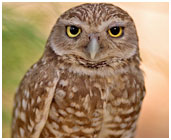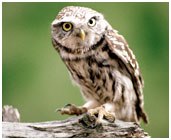Owl is a bird that is found inhabiting almost all the parts of the world. In this article, we have provided a number of interesting facts and some amazing information on owls.
Facts About Owl
Owl is a bird of prey i.e. it hunts other living creatures for the purpose of obtaining food. Owls are carnivores and the most common preys of an owl are small mammals, insects and other birds; however, there are some species of owls who hunt fish also. It usually has a large, round head, along with forward-facing eyes. The sharp, downward-facing beak of an owl, along with its cryptically colored plumage, makes it easily distinguishable from other bird species and their size may vary from 13.5 cm to 70 cm. Owls can be found inhabiting all the continents of the world, with the exception of Antarctica. The owls can be divided into two families namely, the typical owls called the Strigidae and the barn owls known as the Tytonidae. In case you want to know more about owls, make use of the interesting and amazing information that has been provided in the following lines.

Fast Facts
Kingdom: Animalia
Phylum: Chordata
Class: Aves
Subclass: Neornithes
Infraclass: Neognathae
Superorder: Neoaves
Order: Strigiformes
Families: Two - Strigidae and Tytonidae (others extinct)
Smallest Owl: Elf Owl
Largest Owls: Eurasian Eagle Owl and Blakiston's Fish Owl
Size: 13.5 cm to 2 m (depending upon species)
Weight: 31 gm. to 4.5 kg (depending upon species)
Natural Habitat: Variety of habitats, from thick forests to open prairies
Diet: Carnivorous
Interesting & Amazing Information on Owls
-
More than 200 different species of owls have been found. Owls have wide wings, lightweight bodies and unusually soft, fluffy feathers. These features allow them to have a silent flight. Due to colors of their feathers they can blend with the natural surrounding very well.
-
The eyes of an owl are almost fixed inside the sockets. Thus, it cannot move them too much.
-
Owls are far-sighted and cannot see anything within a few inches of their eyes very clearly.
-
The neck of an owl is so flexible that it can rotate its head three-quarters of the way around.
-
Owls do not encounter any problem in seeing during the day and their eyesight is exceptionally good at night.
-
Amongst all the birds, the hearing of an owl is the best. Its ears are located on the sides of the head, hidden by feathers.
-
With the exception of a few species, owls are nocturnal and hunt at night only, unobserved by humans. Owls can fly very silently which makes them one of the most skillful birds of prey.
-
The feet of an owl are very strong and have two toes facing forward and two toes facing backward.
-
Owls use a wide variety of sounds or vocalizations, for the purpose of communication.
-
The female owl lays eggs in intervals of 1-3 days. This is the reason why all the eggs of an owl do not hatch at the same time.
-
Owls do not make nests. Rather, they look for a sheltered nesting site, in trees, underground burrows, buildings, barns or caves.
-
Owls are mainly solitary creatures. However, a group of owls is known as a parliament.
-
After eating, owls regurgitate pellets, containing the indigestible bones, fur and feathers of their victims.
-
Male and female owls have almost the same appearance. Though the latter is often up to 25 percent larger than the former.
-
Owls are carnivorous birds and feed on insects and small rodents including mice, rats and hares. There are some species of owls which are very skillful in hunting fish.
-
Owls have short beaks which are curved downwards and the characteristic sounds they make also vary from species to species. The hoot is generally is made to mark territories however, all species of owls don’t hoot. The sounds produced by other species of owls are hisses, screams and screeches etc.
-
Owls bear special significance in different mythologies. For the Uto-Aztec tribe, the Hopi taboos surrounding owls symbolizes evil. Owls are considered to be bad omens by the Arabs. However, in Hinduism owls are worshipped and are depicted as the mount of Goddess Lakshmi. On the other hand the Kenyans believe owls to be the forerunners of death.


See also
More in 'Society'
More from iloveindia.com
- Home Remedies | Ayurveda | Vastu | Yoga | Feng Shui | Tattoos | Fitness | Garden | Nutrition | Parenting | Bikes | Cars | Baby Care | Indian Weddings | Festivals | Party ideas | Horoscope 2015 | Pets | Finance | Figures of Speech | Hotels in India : Delhi | Hyderabad | Chennai | Mumbai | Kolkata | Bangalore | Ahmedabad | Jaipur
- Contact Us Careers Disclaimer Privacy Policy Advertise With Us Lifestyle Sitemap Copyright iloveindia.com. All Rights Reserved.


